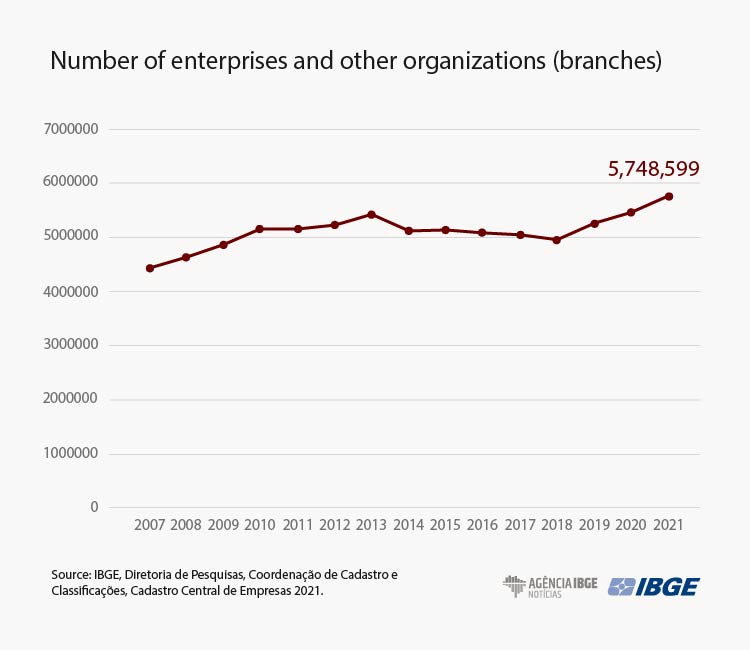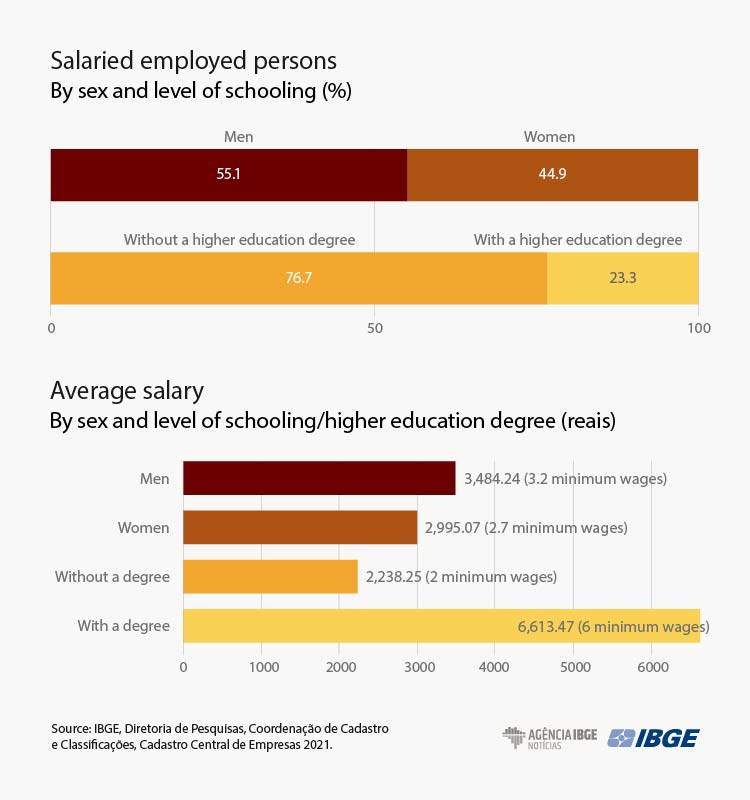Central Register of Enterprises
CEMPRE 2021: number of enterprises increases by 5.8% and that of salaried persons goes up by 4.9%
June 21, 2023 10h00 AM | Last Updated: June 27, 2023 01h47 AM
Highlights
- In 2021, the number of enterprises and other active organizations increased by 5.8% Against 2020, having reached 5.7 million and the number of partners and owners went up by 5.1%, adding up to 7.7 million.
- In the same period, the number of salaried employed persons and Other formal organizations reached 47.6 million, advancing by 4.9% against 2020, with a total of 2.2 more formal jobs in the country.
- The activity Trade, repair of motor vehicles and motorcycles accounted for the highest shares in three of the four variables considered: number of enterprises (32.9%), total employed persons (21.0%) and salaried employed persons (19.2%).
- Public administration, defense and social security was the sector with the highest share in Salaries and other compensation (23.8%).
- The main contributions to the increase in salaried employed persons came from Trade, repair motor vehicles and motorcycles (428.5 thousand) and manufacturing industry (386.9 thousand). The biggest decrease was recorded by Other service activities (-34,3 thousand).
- In 2021, salaried employed persons consisted of 55.1% of men and 44.9% of women. Against the previous year, there was an increase of 4.9% in the number of salaried persons, being 6.3% of women and 3.8% of men.
- Female participation in salaried employed persons of enterprises (44.9%) went back to the pre-pandemic level.
- In real terms, the wage bill (R$ 2.0 trillion) increased by 0.3% from 2020, whereas the average salary paid by enterprises dropped 2.6%, from R$ 3,353.07 to R$ 3,266.53.

In 2021, the country had 5.7 million enterprises and other active formal organizations, an increase 5.8% (314.5 thousand branches) against the previous year. These enterprises had 47.6 million salaried employed persons. As for salaried persons, there was an increase of 4.9% from 2020, which means 2.2 million jobs more. Total salaried persons also increased by 4.9%, or 2.6 million persons more, whereas the number of partners and owners had an increase of 5.1% (372.3 thousand persons). These data come from the Central Register of Enterprises (CEMPRE), released today (21) by the IBGE.
The section Trade; repair of motor vehicles and motorcycles recorded the highest shares in three of the four variables: number of enterprises and other organizations (32.9%), employed persons (21.0%) and salaried persons (19.2%). In Salaries and other compensation it was in the third position (13.0%). And the leader was Public administration, defense and social security (23.8%).
“In 2021, the number of enterprises increased at a higher pace, against 2020, a year marked by effects of the pandemic on businesses. From 2019, cumulative increase was 9.7%, a total of 5.7 million,” says the survey technician Eliseu Oliveira.

The main activities accounting for the increase of 2.2 million in salaried persons were: Trade, repair of motor vehicles and motorcycles (428.5 thousand), Manufacturing industry (386.9 thousand), Public administration, defense and social security (260.4 thousand) and Administrative activities and complementary services (202.8 thousand). Other service activities (-34.3 thousand), on the other hand, accounted for the main decrease.
There were increases in salaried employed persons in 18 of the 20 economic activities analyzed by the survey. The main increases were registered by Real estate activities (13.7%), Professional, scientific and technical activities (12.2%) and Information and communication (12.0%). The only decreases in number of salaried persons were those of International bodies and other extraterritorial institutions (-0.1%) and Other service activities (-4.7%).
Against 2020, number of business entities and of public administration bodies increase
As for the legal nature of enterprises, business entities stood out as 91.4% of the total. In addition to that, They held 75.5% of the total employed persons, 72.1% of the salaried employed persons and 62.1% of the salaries and other compensation.
In spite of their 0.4% of participation in the total enterprises and Other organizations, public administration bodies had 18.2% of the total employed persons, 21.2% of the salaried employed persons and paid 31.4% of salaries and other compensation.
Representing 8.2% of the total organizations, non-profit entities had the lowest rates of participation in the variables analyzed, with 6.3% of the total employed persons, 6.7% of the salaried employed persons and 6.4% of the salaries and other compensation.
From 2020 to 2021, the number of enterprises and other organizations of business entities increased by 6.4%, whereas in the public administration bodies, the increase amounted to 0.5%. As for non-profit entities, decrease amounted to 0.8%. Total and salaried employed persons increased in the three groups of enterprises. But salaries and Other compensation increased in business entities, only (4.2%).
Regarding salaries, in spite of being the majority, business entities paid the lowest wages (R$ 2,823.79), while public administration bodies recorded a decrease of 6.2%, as well as non-profit entities (-1.6%).
Men are the majority and earn higher salaries, but female participation increases again
About 55.1% of the salaried employed persons were men and 44.9%, women; the former got 59.2% of salaries, withdrawals and other compensation, whereas the latter had 40.8%. Against 2020, there was an increase of 4.9% in salaried persons (6.3% in the number of women and 3.8% in the number of men). In terms of salaries, men earned an average salary above that of women, R$ 3,484.24, against R$ 2,995.07, a difference of 16.3%. Women earned, on the average, a total 86.0% of the average salary of men.
“In 2021, female participation increased again, and reached 44.9%, after a drop in 2020, when it had reached 44,3%. Since the start of the time series, in 2009, female participation showed increase. It went from 41.9% that year, to 44.8% in 2019,” Mr. Oliveira explains.
As for schooling, 76.7% of the salaried employed persons did not have higher education, and 23.3% did. Salaries and Other compensation paid to persons without higher education corresponded to 52.4% of the total, whereas salaries of persons with a higher education degree made up 47.6%.
Salaried employed persons without higher education earned, on average, R$ 2,238.25, which is equivalent to 33.8% of the average amount paid to persons with a higher education degree (R$ 6,613.47). So, persons in this group earned, on average, three times more than persons without the degree.
The section Lodging and feeding was responsible for the biggest share of salaried employed persons without higher education (95.9%). The activity Education had the biggest share of salaried persons with this level of schooling (65.2%).

Wage bill increases by 0.3%, but average salary decreases by 2.6%
The sum of salaries and other compensation paid by enterprises and organizations amounted to R$ 2.0 trillion in 2021, in real terms, an increase of 0.3% in relation to 2020. The average Monthly salary had a real decrease of 2.6%, with a change from R$ 3,353.07 to R$ 3,266.53. The highest values were paid by Electricity and gas (R$ 7,472.39), followed by Financial activities, insurance and related services (R$ 7,275.82) and International bodies and other extraterritorial organizations (R$ 6,630.96). Figures are 128.8%, 122.7% and 103.0%, respectively, above average. In terms of number of minimum wages earned, the national average was 3.0, being 3.2 for men and 2.7 for women.
The lowest salaries were paid by Lodging and feeding (R$ 1,599.56), Administrative activities and complementary services (R$ 1,956.69) and Agriculture, livestock, forestry, fishing and aquaculture (R$ 2,171.00) which, respectively, are 51.0%, 40.1% and 33.5% below the average.
The salaries of women fell by 1.8%, from R$ 3,049.99 to R$ 2,995.07, whereas salaries of women fell by 3.1%, from R$ 3,595.09 to R$ 3,484.24. The average monthly salary of salaried employed persons without a higher education degree dropped 1.4%, with a change from R$ 2,269.00 to R$ 2,238.25, and that of persons with higher education dropped 4.0%, from R$ 6,891.96 to R$ 6,613.47.
The highest salaries were paid in the Federal District (average of 5.1 minimum wages) and Amapá, (3.5 minimum wages). Rio de Janeiro and São Paulo followed, with an average of 3.4 minimum wages. The lowest of Alagoas and Paraíba (2.2 minimum wages, in both).
Southeast has highest concentration of local branches in the country
The Southeast has the highest concentration of local branches, total and salaried employed persons, besides salaries and other compensation. In 2021, it accounted for 3.2 million local branches in the country (50.4%); 27.1 million employed persons (49.1%); 23.2 million salaried persons (48.7%); and R$ 1.0 trillion salaries and other compensation (52.5%).
The South Region was in the second position in terms of local branches (22.5%), total employed persons (18.5%) and salaries and other compensation (17.0%). As for salaried persons, it was in the third position (17.7%), behind the Northeast (18.7%), which was in the third position in terms of local branches (14.9%) ad salaries and other compensation (14.7%).

In the ranking by state, São Paulo kept the highest share in number of local branches (30.7%), total employed persons (28.6%), salaried employed persons (28.3%) and salaries and other compensation (32.6%). Minas Gerais is in the second position regarding local branches (10.5%), total employed persons (10.5%) and salaried employed persons (10.4%), and in third position as for salaries and other compensation (9.0%). Rio de Janeiro was in the third position regarding employed persons (8.0%) and salaried persons (8.1%), besides the second position in salaries and other compensation (9.2%) and the fifth position in local branches (7.2%).
Against 2020, the number of local branches increased in all the Major Regions and states, mainly in the Central West (7.3%) and North (6.2%). As for total and salaried persons, the North (6.2%, for both) and Northeast (5.7%, for both) recorded the highest increases.
As for salaries and other compensation, there were increases in the South (1.5%) and Southeast (1.3%). The biggest decreases were those in the Central West (-2.5%) and in the North (-2.0%).
About the survey
The Central Register of Enterprises (CEMPRE) presents statistics of the universe of enterprises and other formal organizations and their respective local branches in Brazil, by economic activity, legal nature, size and geographic distribution, with a highlight to the share of salaried employed persons by sex and level of schooling. Data about the survey are available at the Sidra database.




















